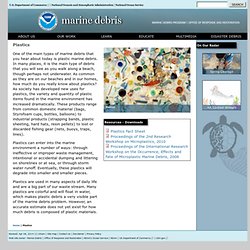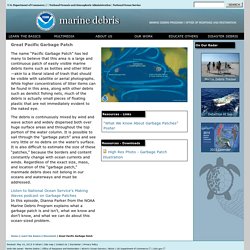

NOAA Marine Debris Program - Welcome. Marine Debris Program - Marine Debris Info. One of the main types of marine debris that you hear about today is plastic marine debris.

In many places, it is the main type of debris that you will see as you walk along a beach, though perhaps not underwater. As common as they are on our beaches and in our homes, how much do you really know about plastics? As society has developed new uses for plastics, the variety and quantity of plastic items found in the marine environment has increased dramatically.
These products range from common domestic material (bags, Styrofoam cups, bottles, balloons) to industrial products (strapping bands, plastic sheeting, hard hats, resin pellets) to lost or discarded fishing gear (nets, buoys, traps, lines). Plastics can enter into the marine environment a number of ways: through ineffective or improper waste management, intentional or accidental dumping and littering on shorelines or at sea, or through storm water runoff. Marine Debris Program - Marine Debris Info. The name “Pacific Garbage Patch” has led many to believe that this area is a large and continuous patch of easily visible marine debris items such as bottles and other litter —akin to a literal island of trash that should be visible with satellite or aerial photographs.

While higher concentrations of litter items can be found in this area, along with other debris such as derelict fishing nets, much of the debris is actually small pieces of floating plastic that are not immediately evident to the naked eye. The debris is continuously mixed by wind and wave action and widely dispersed both over huge surface areas and throughout the top portion of the water column.
It is possible to sail through the “garbage patch” area and see very little or no debris on the water’s surface. It is also difficult to estimate the size of these “patches,” because the borders and content constantly change with ocean currents and winds. Marine Debris Program - Marine Debris Info. What is marine debris?

Our oceans are filled with items that do not belong there. Huge amounts of consumer plastics, metals, rubber, paper, textiles, derelict fishing gear, vessels, and other lost or discarded items enter the marine environment every day, making marine debris one of the most widespread pollution problems facing the world's oceans and waterways. Marine debris is defined as any persistent solid material that is manufactured or processed and directly or indirectly, intentionally or unintentionally, disposed of or abandoned into the marine environment or the Great Lakes. It is a global problem, and it is an everyday problem.